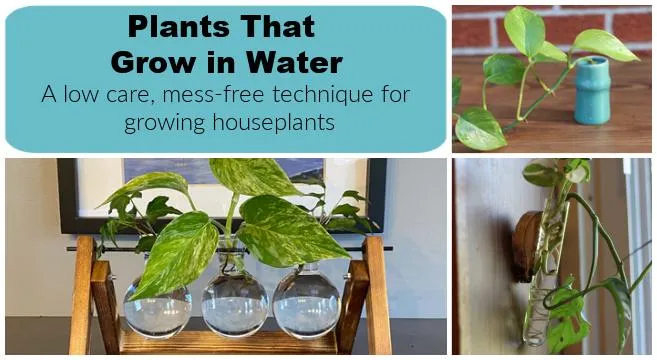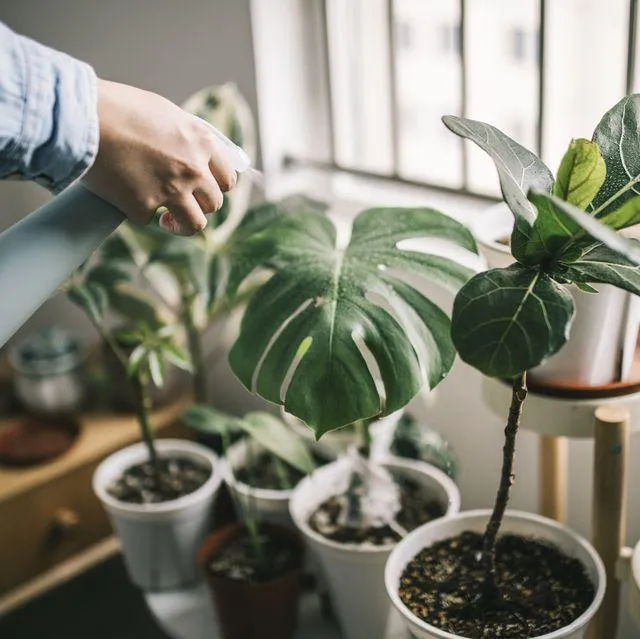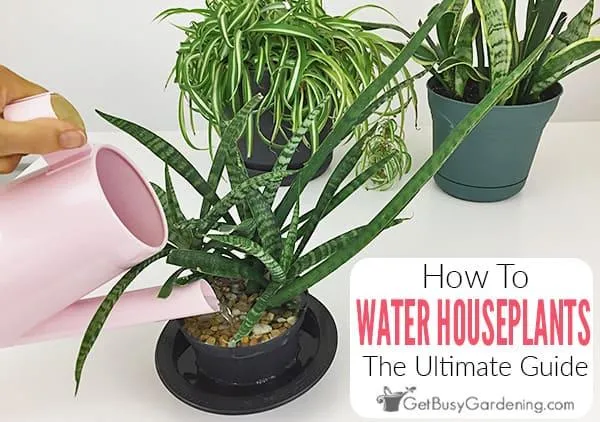The Complete Guide to Watering Your Indoor Hanging Plants
Watering indoor hanging plants properly is key to keeping them healthy and thriving. If you get it wrong, your hanging plants could end up wilted, brown, or even dead. In this article, I’ll cover everything you need to know to water your hanging plants like a pro.
Check Soil Moisture Before Watering
The most important thing is to only water when the soil is dry. From my experience, one of the biggest mistakes plant parents make is watering too frequently without checking the soil first. The easiest way to check is by sticking your finger about an inch into the soil. If it feels dry, it’s time for a drink. If the soil still feels moist, hold off on watering for now.
You can also lift the pot. A light pot means the soil is dry, while a heavy pot means the soil is still moist. Getting into the habit of checking before each watering prevents overwatering, which is one of the leading causes of hanging plant death.
Water Thoroughly Until Drainage
Once you’ve determined the soil is dry, it’s time to water. But don’t just give it a little sprinkle – water thoroughly until it flows freely from the drainage holes. This completely saturates the soil so the whole root ball gets hydrated. I like to place the pot in the sink or shower and run water into it until it flows out the bottom.
The key is to water enough that it drains out. This prevents moisture buildup that can cause root rot. Let the excess water drain out fully before returning the pot to its hanging spot.

Adjust Watering Based on Plant Type and Conditions
Some hanging plants like peperomias and pothos are very tolerant of dry soil and don’t need to be watered as frequently as others. Plants in low-light conditions may dry out more slowly too. On the other hand, tropicals like philodendrons and spider plants typically need water every 5-7 days.
It also helps to adjust your watering schedule based on indoor conditions. If it’s very dry due to heat, you may need to water more often. I’ve found that plants near sunny windows often dry out quicker too. Check the soil regularly and don’t be afraid to modify your watering as needed.
Water Less in Winter
Another thing to keep in mind is that hanging plants need less water in the winter months when days are shorter and indoor heating is used. The reduced light and lower humidity means the soil takes longer to dry out. I usually cut back my watering frequency by around 25-30% in late fall and winter to prevent overwatering.
Use the Right Water
When it comes to water choice, tap water is generally fine for watering indoor hanging plants. However, if your tap water has a high mineral content, it can leave deposits that harm plants over time. In that case, consider using filtered or distilled water instead. I also avoid water sitting out for more than a day, as it can start growing bacteria.
Troubleshoot Watering Issues
Even when you think you have watering down, issues can still come up sometimes. Here are some common problems I’ve faced and how to fix them:

- Yellowing or browning leaves – This is usually caused by overwatering. Reduce watering frequency and make sure the soil fully dries out between waterings.
- Wilting even when soil is moist – The roots may be rotted from too much moisture. Check the roots for dark, mushy sections and cut them away before repotting in fresh soil with better drainage.
- Droopy leaves after watering – The soil could be staying too wet. Consider switching to a pot with drainage holes or using heavier potting mix to allow for better drainage.
- No new growth – Underwatering is likely the cause. Increase water frequency and amount to fully saturate the soil each time.
With a little trial and error, you’ll figure out each plant’s individual needs. Don’t get discouraged – hanging plants are pretty resilient and usually bounce back with the right watering adjustments.
Watering Hanging Baskets
Hanging baskets present an extra challenge because water has a tendency to run straight through the drainage holes without properly hydrating the whole pot. Here are my tips for proper hanging basket watering:
- Fill a watering can, jar, or bottle and pour water slowly all over the top of the soil until it starts to run out the bottom.
- For very thickly planted baskets, you may need to use a water wand with multiple settings to get water below surface layers.
- I like to give baskets a good soaking at least once a week, plus light mistings in between on hot days.
- Adding a layer of sphagnum moss on top helps hold in moisture and prevents soil from washing out holes.
The key is to thoroughly saturate the entire root ball without overly drenching. By following these tips, your hanging plants will be hydrated and happy for seasons to come!
Watering FAQs
Here are answers to some other common watering questions I often get:
- How often should I water? Frequency varies greatly based on plant type, pot size, light, humidity and season. Check soil moisture regularly rather than following a fixed schedule.
- Should I water from the top or bottom? Top watering is sufficient for most plants if done properly until drainage. Bottom watering is best for very thick pots that take forever to dry out.
- What if I forget to water? Don’t panic – missing one watering typically won’t harm plants. Just water thoroughly next time and watch for signs of drought stress like wilting. Most bounce back quickly with water.
- Should I remove hard water deposits? It’s best to wipe mineral deposits off leaves for aesthetic reasons. They won’t directly harm plants but can build up over time on the pot surface.
- What about using ice cubes? Ice can work in a pinch but doesn’t provide the deep watering roots need long-term. It’s best as an occasional supplement, not a replacement for regular waterings.
I hope these tips help you keep your hanging plant family happy and thriving! Let me know if you have any other watering questions – I’m always happy to help plant parents succeed. Your hanging greenery will thank you for it, I promise.

Watering Guidelines for Indoor Hanging Plants
| Plant Type | Water Needs | Signs it Needs Water |
|---|---|---|
| Pothos | Allow soil to dry out between waterings. Water when top 1 inch of soil is dry. | Leaves will start to wilt and droop. |
| Philodendron | Water when top inch of soil is dry. Keep soil moist but not soggy. | Leaves will start to look limp and soil is completely dry. |
| Spider Plant | Allow soil to dry out between waterings. Water when top 1 inch of soil is dry. | Leaves will start to look limp and curl. |
| Peperomia | Keep soil lightly moist. Water when top inch of soil is dry. | Leaves will start to look wrinkled. |
| English Ivy | Keep soil lightly moist. Water when top inch of soil is dry. | Leaves will start to look shiny and limp. |
FAQ
-
How often should I water my indoor hanging plants?
Most indoor hanging plants need water around once a week. However, it really depends on the type of plant and how quick its soil dries out. Basically, stick your finger in the soil and water when the top inch feels dry. Different plants have separate watering needs.
-
Should I water from above or below for hanging plants?
You can water hanging plants either way. Watering from above works well if you use a watering can with a long spout. Basically, just pour water onto the soil surface until it drains out the bottom holes. Watering from below is kind of like giving the plant a shower. You submerge the entire pot in a container of water for 10 minutes.
-
How much water do hanging plants need?
The amount depends on the size of the container. For a 4-6 inch pot, water until it drains out about 1/2 a cup of water. Bigger pots may need a full cup or more. It’s better to underwater than overwater, which can cause root rot. Maybe check the weight before and after watering to get a feel for it.
-
What if I accidentally overwater my hanging plant?
If the soil stays soggy or your plant’s leaves start looking droopy and sad, it was likely overwatered. Do not water it again for at least a week to let the soil dry out. You can also take it out of the pot and check the roots for root rot. Brown, mushy roots need to be trimmed off. Nevertheless, most plants canbounce back from overwatering with some TLC.
-
Can I fertilize indoor hanging plants?
Yes, fertilizing your hanging plants during the growing season will help them thrive. Look for a balanced houseplant fertilizer and follow package directions, typically once a month during spring and summer. Be careful not to over-fertilize which can burn roots. It’s best to skip fertilizer in fall and winter when plants grow slower.

-
My hanging plant isn’t looking so hot. What’s wrong?
A few potential issues for droopy hanging plants are lack of light, underwatering, overwatering, or nutrient deficiency. Check that it’s getting bright, indirect light. Make sure the soil is not soggy wet or bone dry. You might also try fertilizing. Pest problems could also be to blame – check for signs of bugs. If another issue doesn’t appear, repotting may help refresh the soil and roots. With some TLC, your sad plant may perk back up!
-
Any tips for caring for multiple hanging plants?
When you have a whole balcony or wall of hanging plants, stay organized with a watering schedule. Group plants by their individual needs to make it easier. Use markers or tags to identify each plant in case you forget their names. Carefully inspect all plants weekly for any pest or disease problems. Change pots if they get rootbound. Over time, the amazing jungle you’ve created will be well worth the effort!
